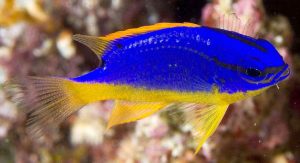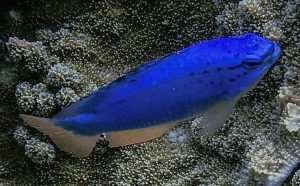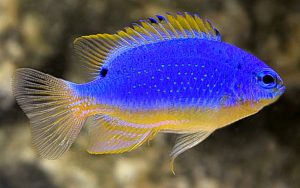Fiji Blue Devil Damselfish (Chrysiptera taupou) known to tropical fish keeping enthusiasts as the Southseas Devil, South Seas Devil Damselfish, South Seas Devil, Tonga Blue Devil Damsel, Fiji Blue Devil, Fiji Devil, South Sea Demoiselle, or Village Belle, is found in the Western Pacific, from the Coral Sea to the Great Barrier Reef, New Caledonia, the Loyalty Islands, Fiji, Samoa, and Vanuatu.
Fiji Blue Devil Damselfish can be found alone, in pairs, or more commonly in small groups in shallow lagoons and offshore coral reefs at depths from 3 to 25 feet where they graze on algae, phytoplankton, and zooplankton. Fiji Blue Devil Damselfish are frequently seen defending small territories as they dart in and out of openings and crevices among the coral reefs in Fiji and Tonga.
Like their closely related cousins Chrysiptera cyanea, the Fiji Blue Devil Damselfish (Chrysiptera taupou) is sexually dimorphic and sexes are easily identified.
Males have a beautiful bright blue body color with a yellow to yellow orange belly, a white tinged chest, and numerous yellow dots on the flanks. They have whitish line on the posterior of the abdomen and a blue dorsal fin. The pelvic and anal fins are yellow, and the caudal fin is blue at the base and yellow towards the posterior. Many adults have a black eye spot at the base and towards the rear of the dorsal fin.
Female Fiji Blue Devil Damselfish are similar to adult males but have yellow dorsal fins that become more transparent towards the rear.
Except for the much paler yellow dots on the body; juvenile Fiji Blue Devil Damselfish look identical to adult specimens.
Fiji Blue Devil Damselfish have the ability to turn almost black when threatened. After the perceived threat is gone, they return to their electric blue and yellow colors in just a matter of seconds.
Chrysiptera taupou and Chrysiptera cyanea look very similar to each other, but Chrysiptera taupou have the yellow belly and yellow dots on the sides. Fiji Blue Devil Damselfish (Chrysiptera taupou) and Blue Damselfish or the Sapphire Devil (Chrysiptera cyanea) were previously regarded by scientests as variants of the same species; which is why tropical fish keeping enthusiasts can still find them in fish stores under the same common name; Blue Devil Damsel. The fact that their geographical range in the northern section of the Great Barrier Reef overlaps may also lend to the confusion.
Fiji Blue Devil Damselfish are aggressive and are best housed in a FOLR aquarium of at least 30 gallon capacity, with a sandy or finely crushed coral substrate and copious amounts of mature live rock arranged into numerous hiding places for them to maintain their territory. They can be extremely aggressive towards conspecifics and will harass much larger tank makes that venture into their territory. Potential tank mates include angelfish, small groupers, wrasses, butterfly fish, clownfish, pseudochromis, etc. Although they are completely reef safe with corals, they are known to attack smaller invertebrates and slower moving peaceful species.
The Fiji Blue Devil is an egg depositing species that has been spawned in an aquarium environment, however, the fry are extremely difficult to rear.
When ready to spawn, the males will prepare a nesting site in their territory on a piece of clam shell, coral, or some smooth rubble. He will then court a fertile female by rapidly swimming in her vicinity, displaying his brilliant colors. if the courting “dance” is successful, the female will deposit her adhesive eggs on the substrate where the male promptly fertilizes them. The females are picky and will travel from nest site to nest site to review several potential mates before selecting a partner.
Spawning itself is similar to other substrate spawners; the female lays up to 20,000 tiny oval adhesive eggs on the cleaned substrate. The male quickly fertilizes them and aggressively guards the eggs from intruders while aerating them until they hatch out, usually less than a week. The hatched larvae drift away with the current as plankton, feeding on zooplankton and phytoplankton before settling to the bottom.
Fiji Blue Devil Damselfish in their natural habitat feed mainly on phytoplankton and zooplankton. In an aquarium environment with mature live rock; they are not choosy and will readily accept a varied diet of live, frozen, or freeze dried brine shrimp, chopped Mysis
shrimp, carnivore and herbivore flakes or pellets, meaty commercial angelfish preparations, and Spirulina based frozen or prepared foods. Small portions that can be consumed within a couple of minutes fed 2 to 3 times a day or more are recommended.
Fiji Blue Devil Damselfish (Chrysiptera taupou) are extremely hardy, relatively inexpensive, and mostly available to tropical fish keeping enthusiasts from tropical fish shops and a multitude of online sources at approximate purchase sizes of 1″ to 3″.
Minimum Tank Size: 30 gallons for singles or pair/ 100 gallons for community
Aquarium Type: FOLR
Care Level: Easy
Temperament: Aggressive
Aquarium Hardiness: Very Hardy
Water Conditions: 72-78°F, dKH 8 to 12 , pH 8.1 – 8.4, sg 1.020-1.025
Max. Size: 3″
Color Form: Blue, Yellow
Diet: Omnivore
Compatibility: Reef w/Caution
Origin: Fiji, Tonga
Family: Pomacanthidae
Lifespan: 5 years
Aquarist Experience Level: Beginner




